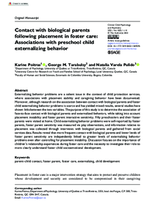Displaying 41 - 50 of 343
A Manitoba advocate for First Nations kids in care hopes a compensation agreement for those hurt by the child welfare system will benefit thousands of children in the province and lead to long-term reform.
There are approximately 11,700 children and youth under state guardianship in Ontario. Black and Indigenous children are highly represented, with Indigenous children comprising 30 per cent of kids under Ontario guardianship alone. Each year, around 1,000 youth “age out” of the system. For many, the transition is difficult, creating lifelong adverse outcomes including low educational attainment and income, unstable housing and homelessness, worse physical and mental health and criminalization.
A number of local Indigenous organizations are calling for a national inquiry into the ‘60s Scoop, which saw tens of thousands of children taken from their families and communities and placed into non-Indigenous homes.
The purpose of this study is to determine the association of face-to-face contact with biological parents and externalized behaviors, while taking into account placement instability and foster parent interactive sensitivity.
The purpose of this study is to determine the association of face-to-face contact with biological parents and externalized behaviors, while taking into account placement instability and foster parent interactive sensitivity.
Canada’s first National Day for Truth and Reconciliation will be held on September 30th, 2021.
The U.S. and Canada are starting to face their history of forcing indigenous children into abusive boarding schools. Here's everything you need to know:
What was the school's goal?
Simply put, cultural genocide. In the 19th and 20th centuries, the U.S. government and religious leaders used compulsory boarding schools to force young Native Americans to give up the languages and cultures of their ancestors, which were considered self-evidently inferior to a Christian, Western-style upbringing. Boarding schools were made mandatory for Native American children in 1891. This often meant forced separation from their families and communities. And because these schools were underfunded, crowded, and often unsanitary, thousands of students died of disease. Canada also coerced at least 150,000 indigenous children into a network of residential schools that were mostly run by the Catholic Church; last June, researchers uncovered 1,148 unmarked graves on the grounds of three schools. U.S. Interior Secretary Deb Haaland, a member of the Laguna Pueblo people whose maternal grandparents were forced to board, has opened an investigation into America's boarding-school policy. "This attempt to wipe out Native identity, language, and culture," she wrote in a June Washington Post article, has "never been appropriately addressed."
Former Canadian senator Murray Sinclair and a group representing survivors of the Sixties Scoop are calling for a federal inquiry into the actions and policies of governments that led to thousands of Indigenous children being taken from their homes over four decades and placed with non-Indigenous families.
Kisha Supernant has brought radar technology to the search for burial sites in Canada while she works to reshape her profession’s relationship with Indigenous communities.



